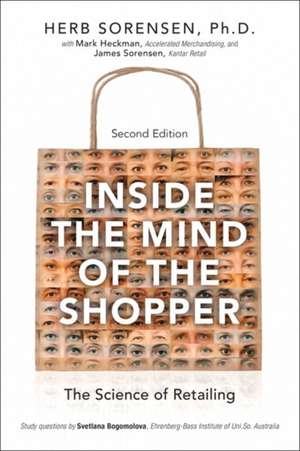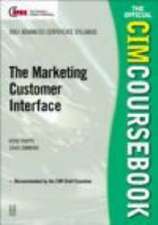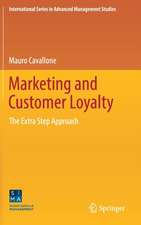Inside the Mind of the Shopper: The Science of Retailing
Autor Herb Sorensenen Limba Engleză Hardback – 24 sep 2016
Preț: 243.29 lei
Nou
46.57€ • 48.53$ • 38.76£
Carte disponibilă
Livrare economică 14-28 decembrie
Livrare express 30 noiembrie-06 decembrie pentru 28.92 lei
Specificații
ISBN-10: 0134308921
Pagini: 280
Dimensiuni: 152 x 229 x 25 mm
Greutate: 0.43 kg
Ediția:2
Editura: Pearson FT Press
Cuprins
Preface: Who Is #1? xxix Introduction 1 Bidirectional Search 2 Products/Shoppers Competition 3 Open Space Actually Attracts Shoppers-Think Navigation! 5 Review Questions 10 Endnotes 10
PART I: TOWARD TOTAL CONVERGENCE OF BRICKS-AND-MORTAR AND ONLINE RETAILING Chapter 1 How We Got Here and Where We Are Going 15 What Is Selling? 16 Selling Requires a Salesperson, Not a Retailer 17 SELLING: Focus on the Big Head of What the Shopper Wants to Buy 18 Stop Shouting at Your Shoppers 21 How We Got This Way 25 Early Shopping in America 26 The Birth of Self-Service Retail 26 Can Selling Make a Comeback in the Twenty-first Century? 32 The Four Dimensions of Purchasing 33 Now! Purchases (Advantage-Bricks Retail) 35 Surprise/Delight Purchases (Advantage-Bricks Retail) 36 Routine/Autopilot Purchases (Advantage-Online Retail) 37 Frustration/Angst Purchases (Advantage-Online Retail) 37 Where Is Selling Going? 37 The Selling Prescription 40 The Shopper's Ideal Self-Service Retail Experience 41 What Does the Ideal Self-Service Retail Store of the Future Look Like? 42 The Dark Store 43 Step-by-Step 44 The Ever-Changing Retail Landscape Favors an Evolving Retailer Species 46 Review Questions 47 Endnotes 48 Chapter 2 Transitioning Retailers from Passive to Active Mode (by Mark Heckman) 49 Passive Merchandising No Longer Suffices in a Shopper-Driven World 50 The Journey to Active Retailing and the Five Vital Tenets of Active Retailing 51 The Five Vital Tenets of Active Retailing 52 Tenet 1: Measure and Manage the Shopper's Time in the Store 53 A Shopper's Time Should Be as Important to the Retailer as It Is to the Shopper! 55 Wasted Days and Wasted Nights 57 Implications for Active Retailing 58 Steps for Managing Shoppers' Time in Store 58 Tenet 2: Focus on the Big Head 59 Implications for Active Retailing 61 Retailers Attempting to Manipulate or Extend a Shopper's Trip Are on a Fool's Errand 62 Steps in Managing the Big Head 63 Tenet 3: Assist Shoppers as They Navigate the Store 63 Mr. Retailer, Tear Down This Wall! 66 Implications for Active Retailing 67 Activating the Dominant Path 68 Steps in Assisting Shoppers as They Navigate the Store 71 Tenet 4: Sell Sequentially 71 What Comes First, The Chicken or the Egg? 72 Does the Order of Things Matter? 72 Implications for Active Retailing 73 Steps for Sequential Selling 76 Tenet 5: Managing the Long Tail 76 So Where Does This Leave the Tens of Thousands of Other Items That Populate the Shelves of the Store? 77 "Nobody Goes There Anymore. It's Too Crowded"-Yogi Berra 77 Implications for Active Retailing 79 Steps in Managing the Long Tail 81 A Passing Thought about the Role of Displays in Active Retailing 82 Closing Thoughts 82 Review Questions 83 Endnotes 83 Chapter 3 Selling Like Amazon Online and in Bricks Stores 85 Amazon Selling Online 87 Amazon Point of Focus #1: Navigation-Simple and Fast 88 Amazon Focus: Selection 89 Amazon Focus #2: Immediate Close 90 Amazon Focus #3: Affinity Sales and Crowd-Social Marketing 91 Amazon Focus #4: Reaching into the Long Tail 93 Amazon Focus #5: Info, Info, Info 94 Amazonian Selling in Bricks Stores 95 Amazonian Bricks Focus #1: Navigation-Simple and Fast 96 Amazonian Bricks Focus: Selection 101 Amazonian Bricks Focus #2: Immediate Close101 Amazonian Bricks Focus #3: Affinity Sales/Crowd-Social Marketing 104 Amazonian Bricks Focus #4: Reaching into the Long Tail106 Amazonian Bricks Focus #5: Info, Info, Info 107 Review Questions 112 Endnotes 113 Chapter 4 Integrating Online and Offline Retailing: An Interview with Peter Fader and Wendy Moe 115 How Did the Internet Change the Study of Shopping Behavior? 116 In What Way Are the Online and Offline Patterns Similar? 117 How Are Paths in the Supermarket Similar to Paths Online? 119 Can Online Retailers Learn from Offline Shopper Behavior? 119 Tell Me about What You've Found Out about Crowd Behavior? 120 What Have You Learned about Licensing and Sequencing-Such as the Purchase of Vice Items After Virtue Items? 120 What Have You Found Out about the Pace of the Shopping Trip? 121 What Have You Learned about Shopping Momentum? 122 What Have You Learned about the Role of Variety in Shopping? 122 What Have You Learned about Efficiency? Is It Better to Allow Shoppers to Get Quickly In and Out of the Store, or Should Retailers Try to Prolong the Trip? 123 This Raises the Question of Whether Shoppers Are in the Store for Utilitarian Reasons Alone or If They Are Interested in an Experience. What Is the Difference? 124 What Have You Learned so far about What Shoppers Are Looking for When They Go Online? 124 How Do Online Retailers Use These Insights about Shopper Visits? 125 This Captures the Whole Point of What We've Called "Active Retailing " Online Is Leading Offline in This Area How Does This Come into the Physical Store? 126 How Do Some of the Complex Forces of Shopping Behavior Play Out? Why Is There a Need for Better Modeling? 126 What Topics Are You Studying Now? 127 Review Questions 127 Endnotes 128 Chapter 5 The Coming Webby Store 129 The "Ideal" Sized Store 135 Review Questions 137 Endnotes 137
PART II: GOING DEEPER INTO THE SHOPPER'S MIND Chapter 6 Long-Cycle Purchasing (by James Sorensen) 141 Higher Cost Leads to Anxiety and Indecision 142 Longer Shopping Process 143 Long-Cycle Purchasing 143 A Word about Building Desire 144 Wish 145 Want 145 Need 145 Got 146 The Shopper Engagement Spectrum 147 Speeding the Shopper along the Path-to-Purchase: First Build Desire and Facilitate the Tipping Point 149 Life Changes 150 Product Benefits 150 Ability to Pay 150 The Shopper's Journey 151 Early in the Shopping Journey 151 Educate 151 Late in the Shopping Journey 152 Validating Choice 152 Complete the Transaction 153 Mobile 153 Again, the Sales Associate Is Key to Closing the Sale and Completing the Transaction 153 Conclusion 153 Review Questions 154 Endnotes 154 Chapter 7 The Quick-Trip Paradox: An Interview with Mike Twitty 155 How Do You Define a Quick Trip? 155 Why Do Shoppers Make So Many Quick Trips? 158 How Do Pre-store Decisions Affect the Quick Trip? 160 What Factors Do Consumers Consider in Deciding Where and How to Shop? 160 How Do Consumers Think about Shopping Trips? 161 What Did You Learn from This Research? 162 How Could It Be that Even Warehouse Clubs and Supercenters-Whose Design so Strongly Encourages Stock-up Shopping-Receive More Quick Trips than Stock-up or Fill-in Trips? 164 Given that Quick Trips Account for Two-thirds of Shopping Trips, How Can Retailers and Manufacturers Cater to these Shoppers? 165 What Is the Quick-trip Paradox? 165 Given this Paradox, How Can Retailers and Manufacturers Capitalize on the Quick Trip? 166 Could the Shoppers' Motives for Making the Trip Offer Insights into the Best Assortment to Offer? 168 How Can Retailers Best Meet the Needs of Quick-Trip Shoppers? 168 What Are the Implications for Retailers and Manufacturers? 170 Review Questions 171 Endnotes 172 Chapter 8 Three Moments of Truth and Three Currencies 173 Moments of Truth 177 Seeing the Truth: Eyes Are Windows to the Shopper 178 Reach: Impressions and Exposures 182 Stopping Power (and Holding Power) 188 Closing Power 189 Three Currencies of Shopping: Money, Time, and Angst 190 Time 191 Angst: A Vague and Unpleasant Emotion 194 A Complex Optimization 195 Review Questions 196 Endnotes 197 Chapter 9 In-Store Migration Patterns: Where Shoppers Go and What They Do 199 If You Stock It, They Will Come 201 Understanding Shopper Behavior 204 First Impressions: The Entrance 206 Shopper Direction: Establishing a Dominant Path for the Elephant Herds 207 The Checkout Magnet 210 Products Hardly Ever Dictate Shopper Traffic-Open Space Does 211 Open Space Attracts: The Call of the Open Aisle 212 The Great Pyramids 215 New Angles 216 Managing the Two Stores 219 Five Store Designs 221 The Enhanced Perimeter 222 The Inverted Perimeter 223 The Serpentine Design 225 The Compound Store 225 The Big Head Store 226 Where the Rubber Meets the Linoleum 227 Review Questions 227 Endnotes 228
PART III: CONCLUSIONS Chapter 10 Brands, Retailers, and Shoppers: Why the Long Tail Is Wagging the Dog 231 Where the Money Is in Retail 232 Massive Amounts of Data 234 Shifting Relationships 235 A Refreshing Change: Working Together to Sweeten Sales 237 Beyond Category Management 238 A New Era of Active Retailing: Total Store Management 239 Pitching a Category's Emotional Tone More Precisely 245 Retailers Control Reach 246 The Urgent Need for Retailing Evolution 248 Review Questions 251 Endnotes 252 Chapter 11 Conclusion Game-Changing Retail: A Manifesto 253 The Package Is the Brand's Ambassador 258 Review Questions 260 Afterword 261 Index 267
Notă biografică
Herb has conducted studies in North America, Europe, Asia, Australia, and South America. His research has been published in AMA's Marketing Research, The Journal of Advertising Research, FMI Advantage Magazine, Progressive Grocer, and Chain Drug Review. He has also been utilized as an expert source for The Wall Street Journal, Supermarket News, and BusinessWeek. Herb appeared on the television show Dr. Oz as an expert on the movement of the eyes as part of the shopping process. Additionally, he is currently a panelist of Retail Wire's "Brain Trust" and blogs at www.shopperscientist.com.
Herb's career intertwines the world of science with the world of business. His Ph.D. in biochemistry from the University of California at Davis, 1970, resulted in publications ranging from metabolism, to chemical and electron structures. He is also a Diplomate of the American Board of Clinical Chemistry. In 1972 he launched a food laboratory, specializing in nutrition, safety, and HACCP quality programs.
His second company, Sorensen Associates, "The In-store Research Company," grew at an annualized rate of nearly 30% from 1979-2009. In the 90s a mentor, Bob Stevens of P&G, encouraged a sharper focus on "assessment in context." This led to the invention and patenting of PathTracker, a second-by-second method of electronically studying shopper behavior in stores. Early on, PathTracker enjoyed mentoring and advice from Peter Fader, and Herb shared in the honor of the AMA's EXPLOR award in 2007, with Fader and his group at the Wharton School of Business of the University of Pennsylvania.
In 2004 Fast Company Magazine named Herb one of its top 50 innovators. In 2013, he received the Charles Coolidge Parlin Marketing Research Award, "honoring distinguished academics and practitioners who have demonstrated outstanding leadership and sustained impact on the evolving profession of marketing research over an extended period." In receiving this prestigious award, Sorensen joined other marketing research legends such as Robert Wood Johnson, Peter Drucker, Arthur C. Nielsen, George Gallup, August A. Busch III, Paul E. Green, John A. Howard, Philip Kotler, Robert J. Lavidge, and Jagdish Sheth.
Globalization of Herb's work expanded when he sold his company to TNS/Kantar and published the first edition of Inside the Mind of the Shopper and through affiliation with the Ehrenberg-Bass Institute at the University of South Australia as an Adjunct Senior Research Fellow. Herb is collaborating with Mark Heckman on Accelerated Merchandising, increasing sales and profits through shopper efficiency.














